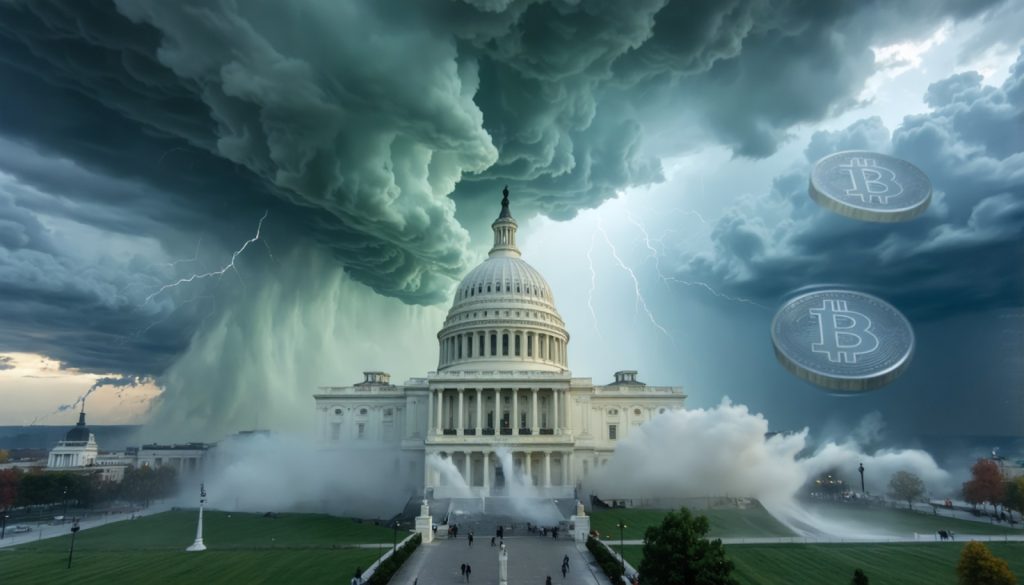
- Senator Elizabeth Warren and Representative Maxine Waters urge the SEC to investigate potential Trump family influence on cryptocurrency enforcement actions.
- The spotlight is on World Liberty Financial (WLF), a crypto firm possibly linked to Trump’s circle, raising concerns about political meddling in crypto regulations.
- The House Financial Services Committee blocks the Federal Reserve from launching a central bank digital currency (CBDC) following Tom Emmer’s bill, reflecting skepticism over government surveillance.
- The STABLE Act, aimed at establishing robust standards for stablecoins, moves forward with bipartisan support, solidifying their role in the U.S. financial landscape.
- The evolving regulatory framework highlights the need for a balance between innovation and oversight, emphasizing transparency and accountability in the crypto ecosystem.
A flurry of activity and intrigue has engulfed the cryptosphere this week, as political figures and legislative actions shape the path ahead for digital asset regulation in the United States. This dynamic landscape is marked by fierce debates over influence, power, and the future of money itself.
Amidst the political murmurings, Senator Elizabeth Warren and Representative Maxine Waters take center stage with their pressing call to the Securities and Exchange Commission (SEC). The lawmakers seek a deep dive into the relationships and potential influence linked to Donald Trump’s family over the agency’s cryptocurrency enforcement actions. At the heart of the inquiry is World Liberty Financial (WLF), a crypto firm ostensibly connected to Trump’s camp. The quest for transparency underscores a democrat-led surge of apprehension about political meddling and conflict of interest within the labyrinth of crypto regulations.
In a parallel narrative, the digital dollar, a potential cornerstone of the U.S. economy’s future, encountered a significant hurdle in Congress. The House Financial Services Committee, swayed by a bill introduced by Tom Emmer, effectively clipped the Federal Reserve’s ambition to roll out a central bank digital currency (CBDC). Emmer’s proposal, rooted in libertarian caution against governmental surveillance, resonated with a significant segment of lawmakers. This development highlights a cautious approach toward adopting centralized digital currencies, mirroring broader Republican unease.
Meanwhile, a legislative stride manifests through the progression of the STABLE Act, which successfully maneuvered through the committee with bipartisan backing. The bill, a keystone for stablecoin governance, aims to establish rigorous standards for audits, reserves, and operational licenses. The act’s propulsion into the legislative limelight represents a pivotal effort to embed stablecoins firmly within the U.S. financial system, acknowledging them not merely as peripheral players but as integral financial instruments.
In these tumultuous times, the American crypto regulatory framework finds itself at an inflection point. As political currents shape the discourse, the overarching message emerges clearer: the future of digital assets lies in striking a balance between innovation and oversight, fostering a financial ecosystem where transparency and accountability coalesce to fortify the new era of digital currency.
Breaking Down the Crypto Regulation Wave: What You Need to Know Now
Insights into the U.S. Crypto Regulatory Landscape
The cryptosphere is currently embroiled in a maelstrom of activity, with recent developments in U.S. crypto regulation capturing global attention. This period is characterized by political intrigue, regulatory scrutiny, and legislative maneuvers, all of which could shape the future of digital assets in America. As lawmakers like Senator Elizabeth Warren and Representative Maxine Waters call for an investigation into the potential influence of Donald Trump’s family on cryptocurrency enforcement by the SEC, the landscape is quickly evolving.
Key Political Developments and Legislative Actions
1. SEC and Trump-Linked Inquiry: The inquiry spearheaded by Warren and Waters highlights concerns about political interference and conflicts of interest, with particular focus on World Liberty Financial, a crypto firm linked to Trump’s camp. This underscores the demand for transparency and accountable enforcement actions within the crypto sector.
2. CBDC Limitations: Congressman Tom Emmer’s proposal has effectively stalled the Federal Reserve’s plans for a Central Bank Digital Currency (CBDC). Emmer’s bill, appealing to libertarian ideals, emphasizes fears over governmental surveillance, demonstrating significant support from lawmakers wary of a centralized digital currency system.
3. Progression of the STABLE Act: The bipartisan approval of the STABLE Act marks a critical step towards integrating stablecoins into the U.S. financial system. The act seeks to enforce stringent standards on audits, reserves, and operational licenses, thus laying the groundwork for stablecoin governance.
Understanding the Broader Implications
– Market Forecasts & Industry Trends: The growing emphasis on regulation suggests a future where cryptocurrencies are no longer fringe assets but critical components of financial systems. Stability in regulation could enhance market predictability, encouraging institutional investment.
– Real-World Use Cases: With clearer regulations, businesses and consumers can use digital currencies with the assurance of legitimacy and security, potentially accelerating adoption.
– Controversies & Limitations: Despite progress, concerns about political influence and regulatory overreach persist. As the industry evolves, balancing oversight with innovation remains a challenge.
Pressing Reader Questions
1. What are the potential impacts of the STABLE Act?
– The STABLE Act could lead to increased stability and consumer trust in stablecoins, likely boosting their use in cross-border transactions and everyday payments.
2. Why are CBDCs controversial?
– CBDCs are seen by some as a potential tool for state surveillance, raising privacy concerns. There’s also debate about their impact on financial stability and the banking sector.
3. How might the SEC investigation affect the crypto market?
– Heightened scrutiny could lead to stricter regulations, affecting market volatility in the short term but potentially ensuring a more sustainable market in the long term.
Actionable Recommendations
– Stay Informed: Regularly check updates from credible sources such as the SEC and financial news outlets.
– Diversify Investments: Consider diversifying your portfolio to include a mix of crypto and traditional assets to manage risk.
Conclusion
The current wave of activity in the U.S. crypto regulatory environment underscores the complex interplay of politics, oversight, and innovation. As these dynamics unfold, stakeholders must navigate the landscape cautiously, balancing the promise of digital currencies with the necessity of robust regulatory frameworks.
For more information on cryptocurrency and financial regulation, visit SEC and Federal Reserve.



